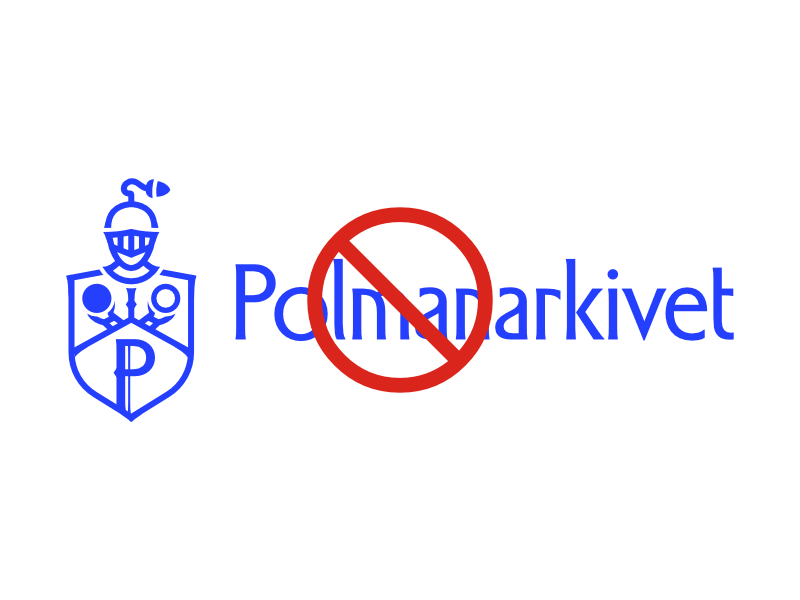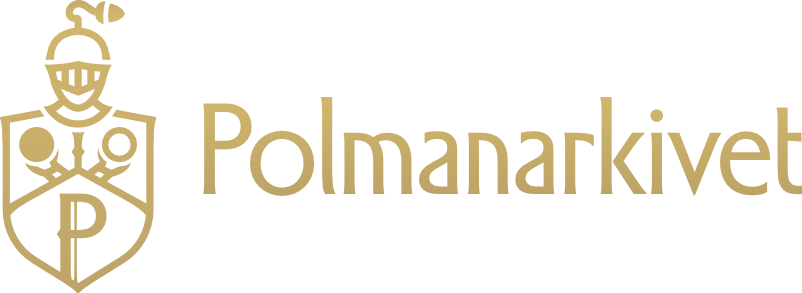Logo
The Coat of Arms icon is our identity, the face of Polmanarkivet. The icon and our strong wordmark are our most recognisable brand assets.
The preferred approach is to use the combined logo — icon and wordmark— in contexts where Polmanarkivet is unfamiliar and the Coat of Arms icon by itself, unlocked from the wordmark when already established to the audience. This allows us flexibility across different forms of communication and to use the logo version with the greatest impact.

Logo Do’s and Dont’s
Using our logos consistently ensures brand recognition and allows for creativity elsewhere. Below are some examples of incorrect use of our logos.






Download Logos
Download our full logo and icon variant in the appropriate colours and vector format.
Colours
Our gold stands out. We have dubbed our unique blend of gold as Polmanarkivet Gold, and it is the most recognisable colour in our brand.
Polmanarkivet uses gold as its main brand colour, with many neutrals to balance when the other colours are too rich, dark, or heavy for the moment. When gradients are unavailable, we use the lighter gold variant as an alternative to Polmanarkivet Gold.
Polmanarkivet Gold
#bda369
#d1b76d
Voice
Polmanarkivet’s voice is evolving to ensure we’re meeting our audience’s needs.
We aim to provide a clear and genuine voice that delights and informs visitors. To achieve this, we will use a consistent voice that uses active voice, avoids slang and jargon, and uses positive language. Our voice uses both functional and expressive voices to create more space for learning and connection.
Typography
We’re using two fonts with endless possibilities: Source Serif 4 and Source Sans 3.
Source Serif 4
Source Serif 4 is a transitional serif typeface and our most versatile font for body copy. It is designed to complement the Source Sans family with its careful match of letter proportions. We have chosen Source Serif 4 for its clarity & legibility on any screen. Thanks to its simplified letter shapes, it is highly readable while also providing a strong character.
Source Sans 3
Source Sans 3 is an open-source grotesque typeface. The slightly condensed letterforms of Source Sans 3 make it ideal for user interfaces where space is a concern. It also makes impactful headlines at large sizes. We use Source Sans for bold headlines and UI elements, including navigation and buttons.
Typography Guidelines
Headings: Source Sans 3
Headlines are set in Source Sans 3. Do not mix other font weights that belong to the Source Sans font family. Always typeset it with optical kerning, set the letter spacing to 0, and set it in sentence case. Do not set it in all caps or all lowercase. When using Source Sans 3 in small headings (around 16px), add letter spacing of 0.2px.
Body text: Source Serif 4
Typeset all text and paragraph text in Source Serif 4. Always typeset Source Serif 4 with optical kerning, set the letter spacing to 0em, and set it in title case or sentence case (as determined by the content).
Headings
Headings play an important role in separating content, making it visually clear and easy to navigate. They guide readers through the text and help search engines understand the structure and relevance of the content.
Heading 1
Heading 2
Heading 3
Heading 4
Paragraph
The Polman, Påhlman, von Pohlmann family can be traced to the Late Middle Ages. It is said that the family came from the parish of Hille, Westphalia, where there was a noble family Polman, whose coat of arms depicted an arm holding a ring.
Blockquote
Polmanarkivet is the largest museum of cultural history and stories about the Polman, Påhlman, & von Pohlmann family. It is home to hundreds of curated digital objects spanning six centuries.
Pull quote
We bring the Polman, Påhlman, & von Pohlmann past to life through stewardship, research, and storytelling.
Callouts
Buttons
Buttons are used to communicate a call to action. Polmanarkivet uses two different styles to signal the actions available.
Buttons are used to execute an action and must have a focus mode to comply with accessibility standards. The text on a button should be short and describe the action the button performs. Primary buttons are used to execute the most desired action. Secondary buttons (used sparingly) are next to primary buttons to execute the second most desired action. The primary Call to Action (CTA) button should be reserved for the most important actions.
Photography
Our photography is authentic. We use imagery that is genuine and specific to time and place.
The photographs we use on Polmanarkivet match the content as closely as possible. If a page mentions an event in the 17th century, for example, an appropriate image from that time period is used where possible. This reflects Polmanarkivet’s emphasis on research and accuracy.
A text description or alt attribute must be used for all images to convey content to those who cannot see the image, except for purely decorative images. It is also recommended to include captions with images, providing supplementary information such as author information and dating.

